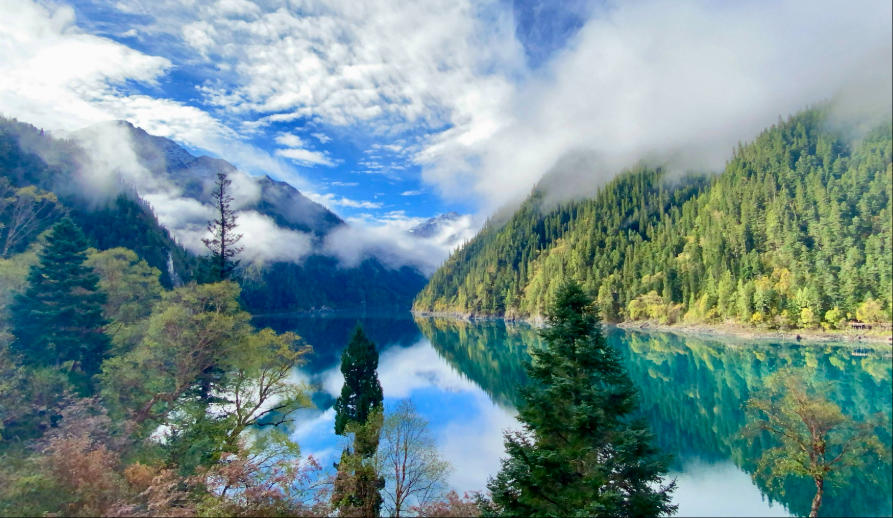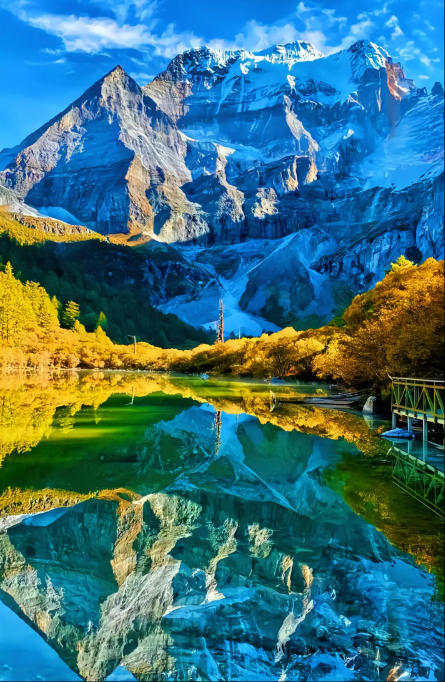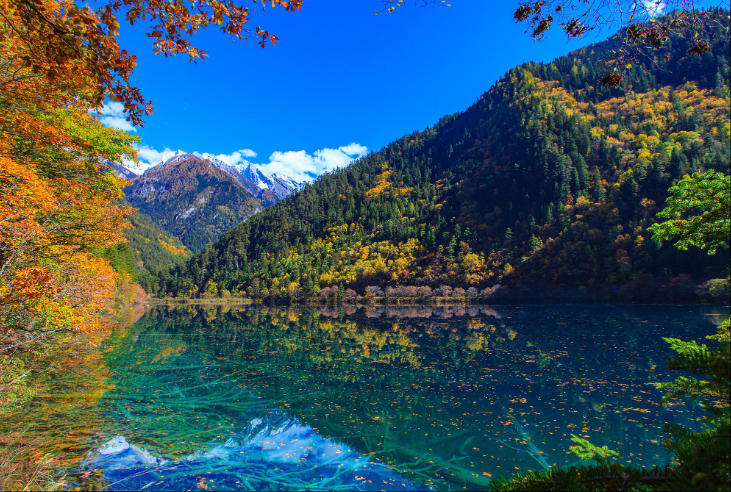Jiuzhaigou Valley Scenic Area is located in Zhangzha Town, Jiuzhaigou County, within the Aba Tibetan and Qiang Autonomous Prefecture, situated in the southern section of the Minshan Mountain Range in northwestern Sichuan Province. It lies over 400 kilometers from Chengdu City and is a major tributary of the Baishui River, a headwater of the Jialing River in the upper reaches of the Yangtze River Basin.
The scenic area spans approximately 720 square kilometers, with most of its terrain blanketed by dense forests. Its landscape is distributed across three primary valleys—Shuzheng, Rize, and Zechawa—which form a Y-shaped configuration stretching over 50 kilometers in total length.

- Shuzheng Valley (the main valley) extends north-south, opening northward with higher elevation in the south and lower in the north. It branches into two tributaries:
- Zechawa Valley to the east, terminating at Long Lake (Changhai).
- Rize Valley to the west, ending at Grass Lake (Caohai).
These two valleys merge at Nuorilang into the Shuzheng Valley. The elevation difference between the lakes at the ends of the two tributaries and the mouth of Shuzheng Valley exceeds 1,000 meters, creating a terraced series of 114 lakes of varying sizes. These lakes are interconnected by 17 waterfall clusters, 11 turbulent stream sections, and 5 travertine shoals.
Together, these diverse water features—alpine lakes, cascading waterfalls, travertine formations, snow-capped peaks, ancient forests, and Tibetan cultural elements—form a harmonious whole. The area is celebrated for its pristine beauty, untamed allure, and natural splendor, making it a world-renowned destination that epitomizes the raw majesty of nature.
1. Introduction to Jiuzhaigou Valley
- Location: Aba Tibetan and Qiang Autonomous Prefecture, Sichuan Province, approximately 400 km (8-hour drive) from Chengdu.
- Highlights: A UNESCO World Heritage Site and national nature reserve, famed for its pristine alpine landscapes. Known as “a place where you’ll never want to see water again after visiting Jiuzhaigou,” it boasts 114 crystal-clear lakes (called haizi), waterfalls, colorful forests, snow-capped peaks, and Tibetan culture.
- Best Seasons:
- Autumn (Sept–Oct): Vibrant foliage reflects on turquoise lakes.
- Summer (July–Aug): Cool retreat with powerful waterfalls.
- Winter (Nov–Mar): Serene snowscapes with fewer crowds (some areas may close).
2. How to Explore Jiuzhaigou
1. Key Zones and Must-See Attractions
The valley is shaped like a “Y” with three main branches:
- Rize Valley (Right Branch): Most scenic area.
- Five-Flower Lake (Wuhua Hai): Multicolored waters, hailed as Jiuzhaigou’s crown jewel.
- Pearl Shoal Waterfall: Filming site for Journey to the West; cascading waters resemble pearls.
- Mirror Lake (Jing Hai): Calm surface mirrors mountains at dawn.
- Zechawa Valley (Left Branch): Highest elevation, featuring large lakes.
- Long Lake (Chang Hai): Jiuzhaigou’s largest and deepest lake, icy blue in winter.
- Five-Color Pond (Wucai Chi): Small but mesmerizing with shifting hues.
- Shuzheng Valley (Main Branch): Ideal for hiking, stretching from the entrance to Nuorilang Waterfall.
- Shuzheng Lakes: A chain of 19 terraced lakes.
- Nuorilang Waterfall: China’s widest travertine waterfall, roaring in autumn.
2. Suggested Itineraries
- One-Day Tour (Compact):
- Morning: Eco-friendly shuttle bus to Rize Valley’s top, then descend to Five-Flower Lake, Pearl Shoal.
- Noon: Transfer at Nuorilang Station to Zechawa Valley for Long Lake and Five-Color Pond.
- Afternoon: Return to Shuzheng Valley for Shuzheng Lakes and Sparkling Lake (Huohua Hai).
- Two-Day Tour (In-Depth):
- Day 1: Rize Valley + Shuzheng Valley.
- Day 2: Zechawa Valley + Zaru Valley (off-the-beaten-path Tibetan cultural experiences).
3. Unique Experiences
- Tibetan Culture: Watch Jiuzhai Eternal Love performance or visit a Tibetan family.
- Hiking Trails: Walk lakeside paths (e.g., Five-Flower Lake to Panda Lake) for secluded views.
- Photography Tips: Capture Mirror Lake at dawn and Five-Color Pond in afternoon light.

3. Tickets & Opening Hours
- Ticket Prices (includes shuttle bus):
- Peak Season (Apr–Nov 15): Entrance ¥169 + Bus ¥90 = ¥259/person.
- Low Season (Nov 16–Mar 31): Entrance ¥80 + Bus ¥80 = ¥160/person.
- Booking:
- Reserve via official website/WeChat (“Jiuzhaigou” or “Aba Travel Network”) with ID; daily cap: 30,000 visitors.
- Discounts for students, seniors, and military personnel.
- Hours: 7:30 AM – 5:00 PM (peak), 8:30 AM – 5:00 PM (low season).
4. Accommodation Guide
1. Staying Outside the Valley (Recommended)
- Jiuzhaigou County (40 km from the valley, budget-friendly):
- Luxury: InterContinental Jiuzhai Paradise (Tibetan-style, hot springs in winter).
- Mid-Range: Hanting Hotel, Holiday Inn Express.
- Valley Entrance (walking distance to the park):
- Luxury: Ritz-Carlton Reserve Jiuzhaigou.
- Mid-Range: Qianhe International Hotel.
2. Staying Inside the Valley (Restricted)
- Policy: Overnight stays are officially banned, but some Tibetan families offer homestays (~¥200–300/person, includes meals).
- Perk: Experience the valley’s tranquility at sunrise.

5. Practical Tips
- Transportation:
- From Chengdu: Bus (¥150, 8–10 hrs from Chadianzi Station), private car (¥200/person), or rare flights to Jiuzhai Huanglong Airport.
- From Chongqing: Take a train/flight to Chengdu first.
- Altitude: Ranges 2,000–3,100 meters; avoid strenuous activity and carry oxygen if needed.
- Eco Rules: No smoking/littering; eat only in designated areas.
- Essentials: Sunscreen, sunglasses, warm layers, and hiking shoes.
6. Avoid Tourist Traps
- Skip low-cost group tours that push shopping.
- Arrive early during peak season (enter by 7:30 AM).
- Bring snacks; park restaurants are pricey.
Jiuzhaigou is nature’s masterpiece—every step unveils a painting. Plan ahead and immerse yourself in this fairyland on earth!